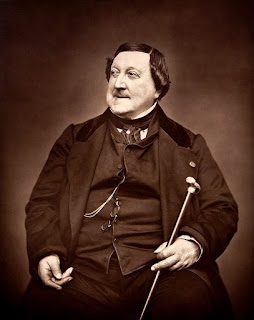- He came from a musical family. His father was a trumpeter in a local orchestra and his mother was a singer.
- He was something of a prodigy - enrolled in a conservatory at 14 and wrote his first opera, La cambiale di matrimonio, at the age of 18. He was famous as an opera composer at 20, and retired from composing operas at 37.
- He was a fan of good food and Wine from an early age. His motivation for working as an altar boy as a child was that he got to drink the left over communion wine. Later on, he dedicated some of his musical pieces to his favourite starters and desserts.
- He could write an Opera in less than a fortnight. He claims it took him just 12 days to write Barber of Seville. He may well have been under the influence of caffeine at the time - he allegedly once commented that the effects of caffeine on the body last 15-20 days, which was enough time in which to produce an opera.
- He was known as a jovial personality, who once claimed that he only cried three times in his life - when his first opera failed, when he first heard Paganini play, and when a truffled turkey fell in the water during a boating party. He loved to entertain and was said to be a witty conversationalist. However, he suffered from severe depression which affected his productivity, suicidal thoughts and pathological obesity.
- His first wife was an opera singer called Isabella Colbran, who was seven years older than he was. A number of the female lead roles in his operas were written with her in mind. When her talent began to wane, he wrote a part for her intended to disguise this fact, but audiences weren't fooled. While the opera, Semiramide, was a success, Isabella was slated by the critics. She retired from opera at 42. This put a strain on their marriage, as Rossini was still very much in demand and always working. She eventually left him.
- After that, Rossini started a relationship with a model and courtesan called Olympe Pélissier, and married her when Isabella died.
- He died of cancer aged 76, but since he was born on February 29th, he'd only recently celebrated his 19th birthday.
- His tomb in the Père Lachaise Cemetery in Paris is large and impressive - but empty, since his wife had his body relocated to Florence where it is buried in the church of Sta Croce.
- He left most of his fortune to Olympe, and when she died, it was used to set up a conservatory of music in his birth town of Pesaro, Italy, and a home for retired opera singers in Paris.
My Books
(for more details and buying options Click Here)
The Ultraheroes series
Several new groups of superheroes, mostly British, living and working (mostly) in British cities like London and Birmingham. People discovering they have, and learning to live with, superpowers. Each book is complete in itself although there is some overlap of characters.
A tale of two dimensions, and worm hole travel between the two. People displaced in both time and space, learning to get along and work together to find a way home while getting used to the superpowers wormhole travel gave them. A trilogy.
Golden Thread
A superhero tale with a difference. Five heroes from another dimension keep returning - whenever they return, they have a job to do and are a well-meshed team in order to do it. Until one time, something goes wrong...
Tabitha Drake series
A different kind of power - the ability to talk to dead people. Tabitha has it, and murder victims seek her out to make sure justice is done. Tabitha has this and a disastrous love life to cope with.
Short story collections
Some feature characters from the above novels, others don't. They're not all about superheroes. Some are creepy, romantic, funny.














